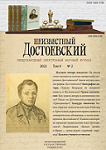Каллиграфические элементы в почерке Достоевского как текстологическая проблема
Calligraphic Elements in Dostoevsky’s Handwriting as a Textological Problem
Author(s): Boris Nikolaevich TikhomirovSubject(s): Language and Literature Studies, Visual Arts, Russian Literature, 19th Century
Published by: Петрозаводский государственный университет
Keywords: F. M. Dostoevsky; poem “On European events in 1854”; textual criticism; attribution; handwriting; calligraphy; fair copy; clerical copy; educational copybooks;
Summary/Abstract: The article deals with a difficult case of establishing the status of a manuscript written with elements of calligraphy, which makes it difficult to determine whether it is a fair copy or a clerical copy. The object of textual analysis was the manuscript of Dostoevsky’s first “Siberian ode” “On European Events in 1854,” the publication of which in several authoritative periodicals addressed the issue in different ways. In the academic Complete Works of Dostoevsky (1st and 2nd editions), the manuscript of the poem, which is stored in the State Archives of the Russian Federation (fund of the III Department), is qualified as a fair copy, although not without hesitation. In the Petrozavodsk Complete Collected Works (“Canonical Texts”), the status of the manuscript is established as a clerical copy. The article shows that the discrepancy in the conclusions of authoritative textual critics is due to the uniqueness of this manuscript, which is written in a special type of handwriting with elements of calligraphy, where numerous letter styles comply with the patterns recorded in the educational copybooks of the 1830–1850s. When establishing the status of the manuscript, the method of double comparison of the handwriting used, on the one hand, with calligraphic notes from Dostoevsky’s 1860s workbooks, and on the other hand, with samples from educational copybooks. This allowed to identify a number of individual features characteristic of the writer in the handwriting version with elements of calligraphy, primarily in the inscriptions of capital letters, and to firmly establish that it is a fair copy. At the same time, handwriting analysis allowed to draw a conclusion about Dostoevsky’s special psychological state in April 1854, three months after he came out of prison. At that time he was working on the manuscript of the patriotic poem “On European Events in 1854,” intended for sending by official means to the capital with the hope of being published in “St. Petersburg Vedomosti”.
Journal: Неизвестный Достоевский
- Issue Year: 9/2022
- Issue No: 2
- Page Range: 37-57
- Page Count: 21
- Language: Russian

